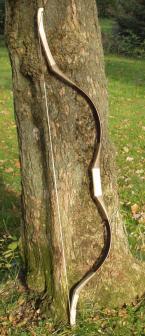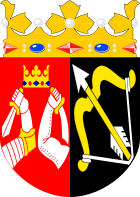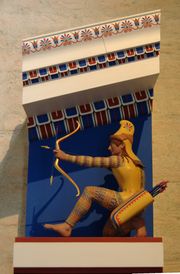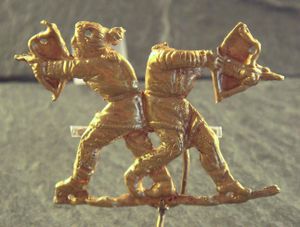Bow (weapon)

A bow is a weapon that projects arrows powered by its elasticity. Essentially, it is a form of spring. As the bow is drawn, energy is stored in the limbs of the bow and transformed into rapid motion when the string is released, with the string transferring this force to the arrow. Bows are used for hunting, for sport (see archery), and still occasionally for war. The development of gunpowder and muskets, and the growing size of armies, slowly led to the replacement of bows as weapons of war. Someone who makes bows is known as a bowyer, and one who makes arrows is a fletcher.
Contents |
Construction

The basic elements of a bow are a pair of curved elastic limbs, traditionally made from wood, connected by a string. By pulling the string backwards the archer exerts compressive force on the string-facing section, or belly, of the limbs as well as placing the outer section, or back, under tension. While the string is held, this stores the energy later released in putting the arrow to flight. The force required to hold the string stationary at full draw is often used to express the power of a bow, and is known as its draw weight. Other things being equal, a higher draw weight means a more powerful bow, which is able to project arrows heavier, faster, or a greater distance.
In bows drawn and held by hand, the maximum draw weight is determined by the strength of the archer. The maximum distance the string could be displaced and thus the longest arrow that could be loosed from it, a bow’s draw length, is determined by the size of the archer. For bows drawn and held mechanically, the maximum draw weight was a matter of engineering. The mechanical force required to draw the string was mainly limited by the time required to do so.
Limbs

The elastic qualities of the limbs of a bow provide a wide variety of performance characteristics. Longer limbs typically provide longer draw lengths, but the archer may have other constraints that limit the possible size of the bow; a mounted archer usually prefers something smaller than the head-high weapon typically employed by his infantry counterpart.
The limbs of the bow must endure repeated bending into a deep curve. The tips of the limbs may consist of a single curve for the longbow, or be bent back upon themselves in the recurve bow. The recurve allows for greater draw weight with shorter limbs, but this places greater strain on the limb materials and may increase string noise when shot. Decurve bows, where the tips bend towards the archer, provide proportionally lower draw weights but may be made with relatively poor materials.
The considerable strain placed upon the limbs of the bow when drawn requires durable materials with high tensile strength and extensibility on the back of the bow, and high compressive strength and compressibility on the belly. Wood is readily obtained, reasonably good for both back and belly, and easily shaped; self bows consisting of a single material are usually of wooden construction. Considerable compromise must be made in selecting a single material, and sophisticated techniques were employed to overcome this problem. The flatbow's cross section is shaped to spread stress more evenly, and the yew for use in English longbows was oriented to take advantage of the ability of the heartwood to store energy in compression, and the outer sapwood's strength in tension.
A composite bow uses a combination of materials to create the limbs, allowing the use of materials specialized for the different functions of a bow limb. The classic composite bow uses wood for lightness and dimensional stability in the core, horn to store energy in compression, and sinew for its ability to store energy in tension. While composite limbs allow greater draw length with shorter limbs, they are typically less robust than a wooden limb. Composite bows are made with water-soluble glue and could be damaged by exposure to moisture.
Modern construction materials for bows include laminated wood, fiberglass, metals, and carbon fiber components.
String
The string that connects the tips of the limbs is under considerable stress when drawn. The string should break only at four to five times the draw weight of its bow. An ideal string material is strong for its mass, resists stretching, and remains strong after exposure to moisture.
Historically bow strings were frequently made from animal byproducts such as sinew, intestine, or hair. Plant fibers such as linen or hemp were also common and usually had a superior ratio of strength to mass. When treated with beeswax they are very resistant to moisture.
Modern synthetic polymers are totally resistant to moisture, have excellent mechanical properties, and are very cheap to produce. Modern compound bows have a mechanical system over which the string (in the form of a steel cable) passes as it is pulled.
Crossbows
In a crossbow, the limbs of the bow are attached to a crosspiece or stock in order to allow for mechanical pulling and holding of the string. This allows for a much larger draw weight than could be drawn and held by hand. A crossbow can be much smaller than a manually held bow of the same power, or may be constructed on a much larger scale like the arbalest and ballista for use as a siege engine.
The drawing of the bow could be accomplished through use of a lever, the archer's legs, or complex windlass designs. The principal disadvantage to a crossbow is the time taken for reloading. While repeating crossbows existed, as did crossbows which shot more than one arrow at a time, for the most part an archer could deliver many times more arrows per minute than a crossbowman could. The weapon's additional weight and the greater potential for mechanical failure could also be a problem for armed forces on the move.
Crossbows require less training and practice than traditional bows, which allowed cheaper and faster raising of troops.
History
Sixty thousand year old stone points which might be identified as arrowheads have been found in a cave in South Africa.[1] By 16,000 BCE flint points were being bound by sinews to split shafts. Fletching was being practiced, with feathers glued and bound to shafts.
The first actual bow fragments are the Stellmoor bows from northern Germany. They were dated to about 8,000 BCE but were destroyed in Hamburg during the Second World War. They were destroyed before Carbon 14 dating was invented and their age was attributed by archaeological association. The second oldest bow fragments are the elm Holmegaard bows from Denmark which were dated to 6,000 BCE. High performance wooden bows are currently made following the Holmegaard design.
Around 3,300 BCE Similaun man was shot through the lung near the present-day border between Austria and Italy and was mummified. Among his preserved possessions were bone and flint tipped arrows and an unfinished yew longbow 1.82 m (72 in) tall.
See also
- Atlatl
- Butt shooting
- Gungdo
- Sling
- Woomera
- Yumi
Notes
- ↑ Lucinda Backwella, Francesco d'Erricob and Lyn Wadley (june 2008). "Middle Stone Age bone tools from the Howiesons Poort layers, Sibudu Cave, South Africa". ScienceDirect. http://www.sciencedirect.com/science?_ob=ArticleURL&_udi=B6WH8-4S044NX-1&_user=10&_coverDate=06%2F30%2F2008&_rdoc=1&_fmt=high&_orig=search&_sort=d&_docanchor=&view=c&_searchStrId=1246615915&_rerunOrigin=google&_acct=C000050221&_version=1&_urlVersion=0&_userid=10&md5=171b606b075a014bc3966bc5d4c80c77.
Further reading
- The Traditional Bowyers Bible Volume 1. 1992 The Lyons Press. ISBN 1-58574-085-3
- The Traditional Bowyers Bible Volume 2. 1992 The Lyons Press. ISBN 1-58574-086-1
- The Traditional Bowyers Bible Volume 3. 1994 The Lyons Press. ISBN 1-58574-087-X
- The Traditional Bowyers Bible Volume 4. 2008 The Lyons Press. ISBN 978-0-9645741-6-8
- U. Stodiek/H. Paulsen, "Mit dem Pfeil, dem Bogen..." Techniken der steinzeitlichen Jagd. (Oldenburg 1996).
- Gray, David, "Bows of the World". The Lyons Press, 2002. ISBN 1-58574-478-6.
- Comstock, Paul. "The Bent Stick"
External links
- The Asian Traditional Archery Research Network
- Simon Archery Collection From The Manchester Museum, The University of Manchester
- An Approach to the Study of Ancient Archery using Mathematical Modeling
|
||||||||||||||||||||

